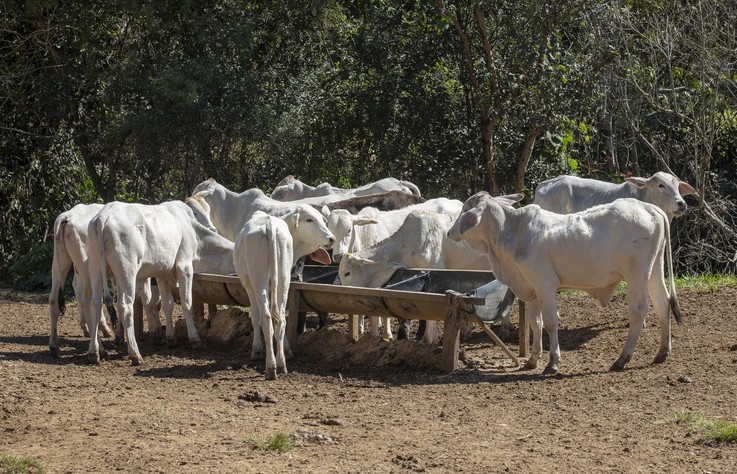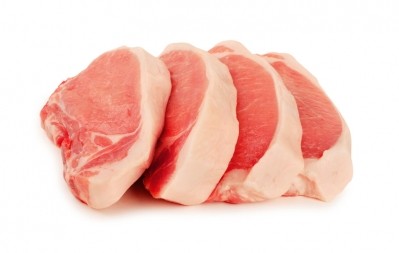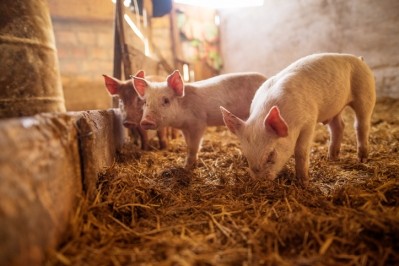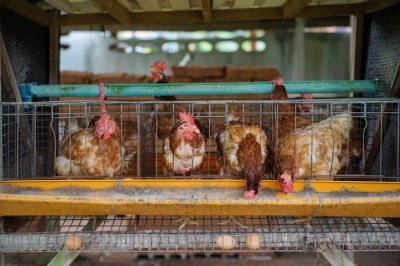Encapsulated additives may boost meat tenderness in feedlot cattle

An international team of researchers from Brazil and Portugal explored the use of encapsulated essential oils on the muscle produced by cattle. The group members published their work in the journal, Meat Science.
“The objective of the present experiment was to evaluate the effects of including essential oils derived from rosemary (Rosmarinus officinalis) and clove (Syzygium aromaticum) or a mixture of their main active compounds encapsulated into the finishing diets for Nellore heifers on the chemical, collagen solubilization, fatty acid profile and structural traits of longissimus muscle, associated with meat structure,” the researchers said.
The researchers found that the encapsulated feed additives did not alter the type of muscle fiber grown, meat chemical composition in the fatty acid profile. But the addition of the supplements increased sarcomere length, raised soluble collagen content and reduced the level of type III collagen found in the tissue.
“The mixture of both active principles and essential oils clove and cinnamon essential oil, have a potential use in animal feed, favoring a greater sarcomere length, that is directly related to the increase of the meat tenderness, without altering the meat chemical composition or fatty acid profile,” they added.
Why examine encapsulated essential oils and muscle fiber?
Global public health concerns have been reducing the use of antibiotics as a feed additive in livestock production, the researchers said. The feed industry has been searching for alternatives that could safely and functionally replace antibiotics.
Essential oils have been explored for their use in animal nutrition and improving feedlot cattle performance and meat quality, they said. “Essential oils are terpenoid compounds that are present as secondary compounds in plants and can be extracted by steam distillation or solvent extraction,” they added.
Essential oils can have anti-inflammatory and anti-microbial properties and may be useful in improving feed efficiency, production and as rumen modulators, they said. They also may alter fatty acid composition in the milk and meat produced.
However, less is known regarding the influence their use has on “muscle structural determinants” and meat tenderness, the researchers said. “Meat tenderness is affected by muscle structural features such as the muscle fiber types and the type of collagen present in the connective tissue,” they added.
Skeletal muscle fibers are categized by their contractile properties and metabolic activities and the type, diameter and number of muscle fiber also have an influence on meat quality, they said. Typically, fibers in skeletal tissue include SO fibers, FG fiber and FOG fibers.
“Understanding the relationship between muscle fiber features and traits of meat quality would increase the high-quality meat production just like the manipulation of muscle fiber features may increase profitability of the meat industry,” they said. “Consequently, the muscle fiber numbers, diameter, type and composition in across-sectional muscle area are important characteristics and influencers of meat quality.”
Feeding trial details
In the feeding trial, 40 22-month-old heifers received one of five finishing diets for a 73-day period, the researchers said.
The diets included a non-supplemented control (CON) and that diet with 4g/animal/day rosemary essential oil (ROS), with a blend of the active principles eugenol, thymol and vanillin at 4g/animal/per (BLE), with the active principle blend at 2g/animal/day and clove essential oil at 2g/animal/day (BCL) or the active principle blend, rosemary essential oil and clove essential oil all at 1.33g/animal/day (BRC), they said.
“The feedlot diets were based on ad libitum feeding of corn grain (647 g/kg of DM) and corn silage (250 g/kg of DM),” they said. “Preparation of diets was made with a premix of essential oils with soybean meal; this premix was then added to the feed mixer with other dietary ingredients.”
“Soybean meal (100 g/kg of DM) was mixed with yeast (0.40 g/kg of DM), phosphorus (0.70 g/kg of DM) mineral salt (1.90 g/kg of DM), essential oils (4 g/animal/d) and top-dressed daily into the morning feeding for respective essential oil treatment pens (ROS, BLE, BCL, and BRC) during the experimental period,” they added. Both essential oils and the essential oil blend were commercially available.
Following the feeding trial, all animals were harvested, and samples of muscle fiber were collected for analysis, the researchers said. Samples were checked for muscle fiber types, sarcomerum length and collagen types I and III along with fatty acid profile, chemical composition and collagen solubility.
Results
The chemical composition including meat moisture, ash, crude protein and total lipids along with muscle fiber types and traits were not altered by the experimental diets, the researchers said. The amount of collagen in the muscle samples also was similar across all diets but the BRC diet showed a higher proportion of soluble collagen than the control.
“It is known that the greater the collagen solubility, the greater the meat tenderness, with lower thermostability, due to the smaller occurrence of crosslinks,” they added.
Type I collagen fiber results were similar for cows on all diets, they said. But, type III was reduced in cows on the BRC diet compared to those on the CON diet.
“Type III collagen may be less soluble during heating than type I. In addition, type III collagen may be involved in the formation of borders between perimysium fibers and the endomysium sheath, which may be important to meat texture properties,” the researchers said. “These characteristics may explain the results of this study, in which the BRC diet had a higher soluble collagen percentage in the longissimus thoracis muscle compared to the CON diet, as well as a lower amount of type III collagen, characterized as having lower solubility.”
Sarcomere length also was greater for cows on the BRC diet than those on the control diet, they said. Adding, “Shorter sarcomeres result in tougher meat.”
However, muscle fiber distribution percent, diameter, area and distribution area were not altered, they said. The differing diets also had little influence on the fatty acid composition in the meat.
Source: Meat Science
Title: The effect of encapsulated active principles (eugenol, thymol and vanillin) and clove and rosemary essential oils on the structure, collagen content, chemical composition and fatty acid profile of Nellore heifers muscle
Authors: J. Monteschio, F. Vargas-Junior, F. Almeida, L. Pinto, I. Kaneko, A. Almeida, L. Freitas, S. Alves, R. Bessa, I. Prado
DOI: published online before print doi.org/10.1016/j.meatsci.2019.04.019

















